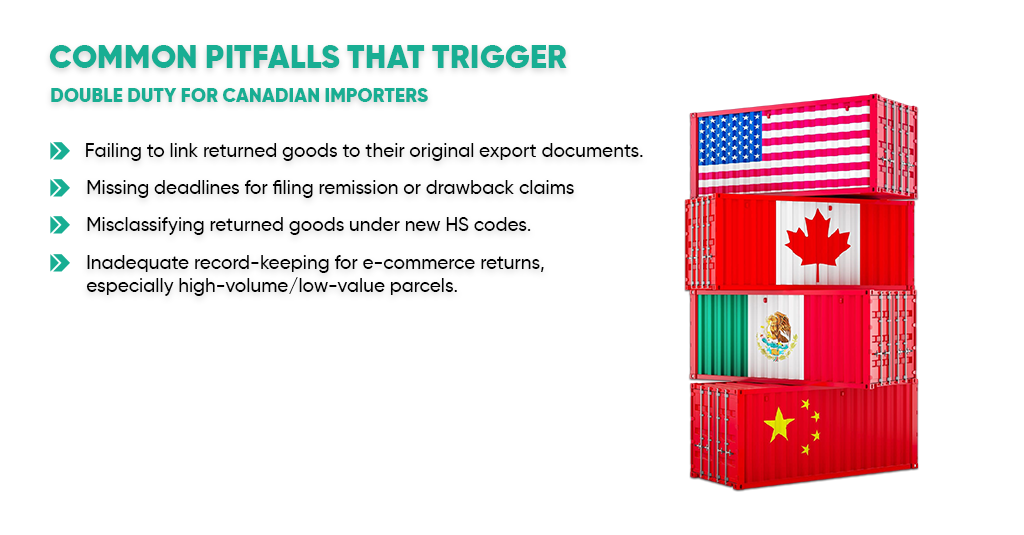Canadian businesses shipping to U.S. customers often face an unexpected challenge when products are returned across the border — double duty. If not handled properly, goods that were originally exported from Canada and then returned, due to returns, warranty issues, or unsold stock, can be treated as new imports by the Canada Border Services Agency (CBSA). This can result in paying duties and taxes twice on the same goods — a costly and avoidable error.
Here’s what Canadian importers need to know to prevent over-paying and to keep cross-border operations compliant and cost-efficient.
1. Why Double Duty Happens
When goods leave Canada for the U.S., they are formally exported. If they later come back into Canada, whether for resale, repairs, or returns, CBSA generally treats them as a new import.
Unless importers can prove that the goods originated in Canada or qualify for CBSA relief programs, duties and GST/HST may be applied again.
For businesses with frequent U.S. returns, like apparel retailers or electronics Suppliers—these costs can add up quickly and eat into profit margins.
2. CBSA Relief Options for Returned Canadian Goods
Canadian importers can often avoid paying duty twice if they apply the correct CBSA relief program and provide proper documentation:
- Duty Remission & Relief Programs – Many returned-goods shipments qualify under CBSA remission orders or duty-drawback provisions. Learn more about how these options work in our guide to Canada Duty Remission and Relief Programs.
- Proof of Canadian Origin – If goods were manufactured or substantially transformed in Canada, importers can use supplier declarations, manufacturing records, or serial numbers to show they originated here and should not be charged duty again.
- Goods for Repair or Warranty – Returns for repair may qualify for temporary importation programs, which can reduce or eliminate duties provided the goods leave Canada again after repairs.
3. Documentation You’ll Need to Avoid Double Duty
Paperwork is critical. Canadian importers should prepare and retain:
- Original commercial invoices from the initial export to the U.S.
- Bills of lading or airway bills showing the goods’ round-trip journey.
- Certificates of origin or manufacturer declarations to support duty-free treatment.
- Evidence of reason for return (e.g., warranty claim, customer return, or unsold goods).
- Any CBSA authorization letters for remission or drawback programs.
Organizing these records digitally can save time and prevent disputes. See our article on Digital Customs Tools for Seamless Trade for tips on moving away from paper-based filing.
4. Common Pitfalls That Trigger Double Duty for Canadian Importers

Even experienced importers make mistakes that trigger double duty:
- Failing to link returned goods to their original export documents.
- Missing deadlines for filing remission or drawback claims.
- Misclassifying returned goods under new HS codes.
- Inadequate record-keeping for e-commerce returns, especially high-volume/low-value parcels.
A proactive compliance checklist helps avoid these issues, especially for SMBs managing both exports and imports.
5. Case Example: Apparel Retailer Avoids Thousands in Duties
A Canadian apparel brand exporting seasonal stock to U.S. boutiques faced thousands in unnecessary duties when unsold garments were shipped back to Canada.
By documenting each SKU’s original export invoice and claiming under CBSA duty-remission rules, the company recovered the overpaid duties and simplified future returns.
This example shows how proper documentation and awareness of CBSA programs can deliver significant savings.
6. Staying Competitive in the Era of Higher Compliance
With cross-border costs rising and the elimination of the U.S. $800 de minimis threshold approaching, Canadian importers can’t afford to lose profit margins on avoidable duties.
Investing in strong record-keeping, aligning HS codes with your brokers, and educating warehouse and logistics teams on remission eligibility can protect your bottom line.
For businesses importing specialized goods, such as e-bike kits, pet products, or even beauty products with Health Canada compliance needs, understanding category-specific rules is equally important.
7. Final Thoughts & CTA
Returned goods don’t have to mean double duty.
By keeping meticulous records, using CBSA’s remission programs effectively, and staying up-to-date on compliance rules, Canadian importers can protect their profit margins and improve cash-flow.
Avoid paying twice on your cross-border returns. Review your documentation processes today and ensure your next shipment qualifies for CBSA duty relief.
8. FAQs
Q1: How do I prove that goods were originally exported from Canada?
Keep your original commercial invoice, export declaration, and bills of lading that link the shipment leaving Canada with the one returning. Supplier declarations or product serial numbers can also help.
Q2: Do I always qualify for duty-free treatment on returned Canadian goods?
No. The goods must meet CBSA’s returned-goods criteria or fit within specific remission/drawback programs. If the product was altered in the U.S. or lacks proof of origin, full duties may still apply.
Q3: What is the deadline to file for remission or drawback on duties already paid?
Typically up to four years from the date of accounting with CBSA, but timelines vary by program. Review Canada Duty Remission and Relief Programs for details.
Q4: Are warranty repair shipments treated differently?
Yes. If the goods re-enter Canada temporarily for repair, or if they were returned for repair and then exported again, they may qualify for temporary importation provisions that reduce or remove duties.
Q5: Can I automate the paperwork for returned goods?
Absolutely. Many importers are turning to digital customs tools to automate data entry, link documents, and store records for future claims.

 Payment
Payment  My Account
My Account